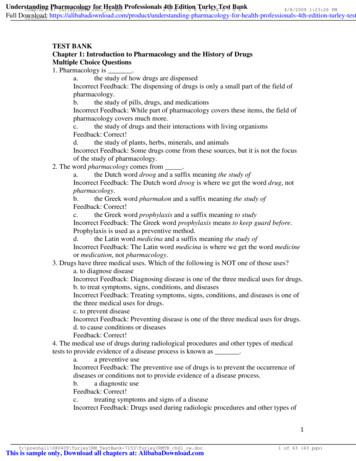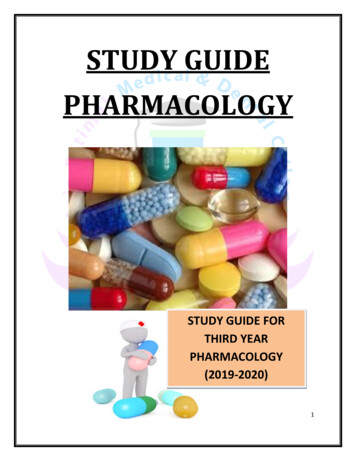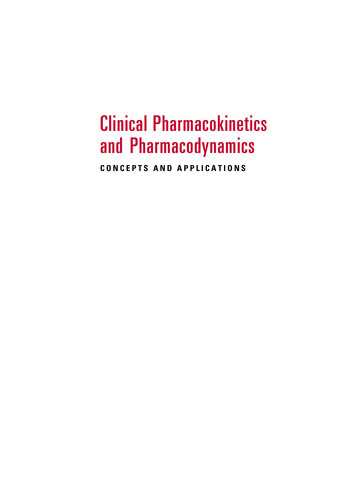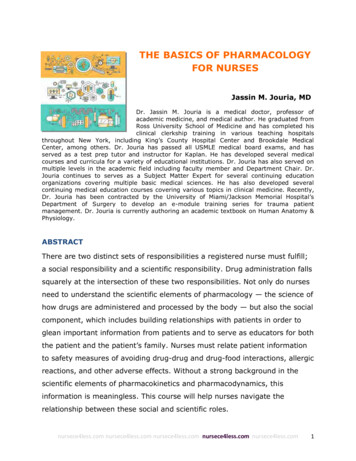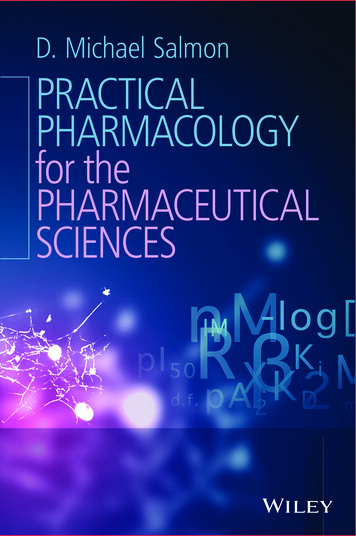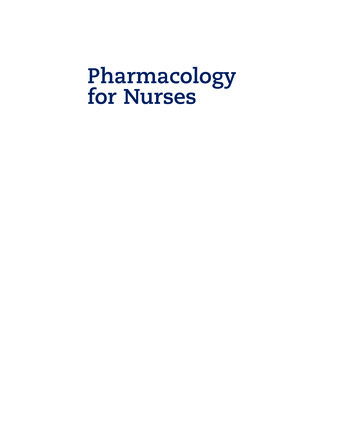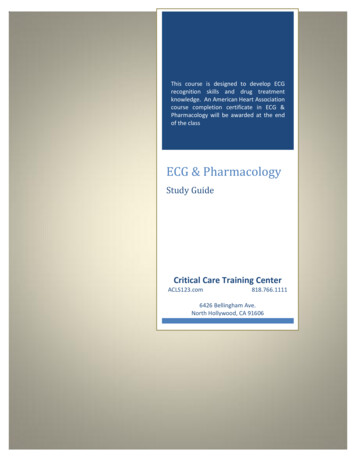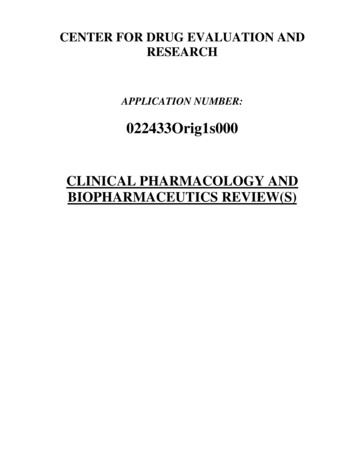
Transcription
CENTER FOR DRUG EVALUATION ANDRESEARCHAPPLICATION NUMBER:022433Orig1s000CLINICAL PHARMACOLOGY ANDBIOPHARMACEUTICS REVIEW(S)
NDA 22-433TicagrelorAppendix I: Individual Studies ReviewThis appendix is an addendum to the clinical pharmacology review checked in DARRTS on06/17/2010.SectionClinical PharmacologyPharmacometricsPopulation imary AuthorIslam R. YounisSecondary ReviewerRajnikanth MadabushiIslam R. YounisKevin M. KrudysKevin M. KrudysPravin R. JadhavMichael A. Pacanowski Issam ZinehAnalytical Methods: wherever it is mentioned throughout the appendix that the performance ofthe analytical method is acceptable, it implies that the method used met the below requirement: Study samples were analyzed within the established stability period: Quality control samples range is acceptable Internal standard was used Method was validated prior to use Chromatograms were provided Calibration range samples accuracy and precision are acceptable Quality control samples accuracy and precision are acceptable Quality control samples precision is acceptableMethod overall performance is acceptable; Yes No; Yes No; Yes No; Yes No; Yes No; Yes No; Yes No; Yes No; Yes No1
NDA 22-433TicagrelorAppendix I Table of ContentCLINICAL PHARMACOLGY.3I. ADME-IN VITRO STUDIES .31. Absorption.32. Distribution .43. In vitro Metabolism.54. In vivo Metabolite Identification .65. Enzyme Inhibition .86. Enzyme Induction.11II. PHARMACOKINETICS .141. Mass Balance Study .142. Single Ascending Dose (1) .163. Single Ascending Dose (2) .184. Single Ascending Dose (3) .215. Multiple Ascending Dose .22III. SPECIFIC POPULATION .271. Renal Impairment.272. Hepatic Impairment .303. Age/Gender .324. Japanese/Caucasian (Single Dose).345. Japanese/Caucasian (Multiple Dose) .375. Chinese.39IV. DRUG-DRUG INTERACTIONS.421. Ketoconazole.422. Diltiazem .443. Rifampin.464. Aspirin.495. Desmopressin .516. Heparin .537. Enoxaprin.558. Digoxin.579. Simvastatin .5910. Atorvastatin.6111. Oral Contraceptive.6312. Midazolam.6513. Tolbutamide .67V. BIOPHARMACEUTICS .691. Absolute Bioavailability .692. Food Effect.713. Clopidogrel BE .72VI. PHARMACODYNAMICS .741. Onset Offset.742. RESPOND.803. Ticagrelor ASA vs. Clopidogrel ASA .894. Loading Dose .915. Uric Acid.936. Respiratory Parameters .96PHARMACOMETRICS.98I. POPULATION PHARMACOKINETICS .98II. EXPOSURE RESPONSE .109PHARMACOGENOMICS .130EDR LINKS .1522
NDA 22-433TicagrelorCLINICAL PHARMACOLGYI. ADME-In Vitro Studies1. AbsorptionStudy # DMY10Title: AZD6140: Investigation of P-glycoprotein-mediated transport of AZD6140 and its activemetabolite AR-C124910 using MDCK cells expressing human MDR1 P glycoprotein Objective: To determine whether ticagrelor and its active metabolite AR-C124910XX aresubstrates for P-gp. Procedure: A monolayer-based transport assay using MDCK cells over expressing humanMDR1 P-gp was run in both basolateral to apical (B. A) and apical to basolateral (A .B)directions. GF120918 was used as an inhibitor of P-gp. Erythromycin (10 µM) andpropranolol (10 µM) were used as positive and negative controls, respectively. Results: Significant unidirectional transport which indicates that both compounds are mainlytransported by P-gp.Flux Ratio (B A/A B)CompoundNo Inhibitor With inhibitorTicagrelor 1 µM33.91Ticagrelor 10 µM9.51.2ARC-124910XX 1 µM14.21.9ARC-124910XX 10 µM9.90.9Erythromycin17.6NDPropranolol0.9ND Conclusion: Both compounds are P-gp substratesComment: Mass recovery was low ( 50%) and hence flux ratios may be underestimated.Study # 6140DMY14Title: AZD6140: Effect of AZD6140 and its metabolite AR-C124910 on P-glycoproteinmediated transport of digoxin Objective: To determine whether ticagrelor and its active metabolite AR-C124910XXinhibits P-gp mediated digoxin transport in vitro. Procedure: Transport of 5 µM 3H-digoxin in MDR1-MDCK monolayer was determined inboth basolateral to apical (B. A) and apical to basolateral (A .B) directions in the presenceand absence of ticagrelor and AR-C124910XX (10 µM). GF120918 was used as an inhibitorof P-gp. Ketoconazole (10 µM) and propranolol (50 µM) were used as positive and negativecontrols, respectively. Effect of both compounds on digoxin transport was further evaluatedat concentrations ranging from 0.1 to 50 µM. Results: Both compound inhibited digoxin transport in dose dependant manner with IC50 of7.8 2.6 μM. and 9.9 5.1. μM for ticagrelor and AR-C124910XX, respectively.3
NDA 22-433TicagrelorFlux Ratio (B A/A 2.4Ketoconazole1.4Propranolol14.1Conclusion: Ticagrelor and AR-C124910XX are inhibitors of Pgp mediated digoxintransport.Compound Comment: Mass recovery was low ( 50%) and hence flux ratios may be underestimated.2. DistributionStudy # SC-103174Title: In vitro binding of [3H]-ARC126532XX to the plasma proteins and blood cells of rat, dog,marmoset, rabbit, mouse, and man. Objective: To determine the blood association and plasma protein binding of ticagrelor indifferent species. Method: Radioactivity was determined by liquid scintillation Protein Binding: 3H-Ticagrelor in plasma (10, 200, 4000 ng/mL) was analyzed byequilibrium dialysis for 3 h (pH 7.4, 37 C). Blood Association: Blood samples containing were spiked with 3H-ticagrelor (finalconcentration (10, 200, 4000 ng/mL) and incubated at 37 C for 30 minutes. ResultsAverage Plasma Protein BindingProtein Binding Blood y # YAT/116Title: AZD6140: An in-vitro study to assess the free fraction of AR-C124910XX and ARC1333913XX in human, marmoset, rat, mouse and rabbit plasma. Objective: To determine the plasma protein binding of ticagrelor metabolites (ARC124910XX and AR-C1333913XX) in different species. Method: Both compounds were incubated with plasma (final concentration of 0.1, 0.5, and 1µg/mL) for 1 h at 37 C prior to equilibrium dialysis analysis for 24 h (pH 7.4, 37 C). Both thediasylate and plasma retenate were assayed by LC-MS/MS. Results4
NDA 22-433TicagrelorAverage Plasma Protein BindingAR-C124910XX 2Mouse98.10.767Rabbit99.746.7Species3. In vitro MetabolismStudy # 6140DMN9Title: In vitro metabolism of [14C]-AZD6140 in human and animal liver preparations Objective: To examine the metabolism of [14C]-ticagrelor in:1. Hepatocytes: Rat, dog, and cryopreserved from human liver tissues.2. Liver Microsomes: Mouse, rat, dog, marmoset, cynomolgus monkey, and human3. Liver S9 fraction: Aroclor induced rat liver. Procedure: [14C]-7-Ethoxycoumarin was used as positive control. Ticagrelor (20 µM , 10.5µg/mL) was incubated with:1. Hepatocytes (2 x 106 cell/mL) for 0, 1, or 4 h.2. Liver microsomes (0.5 mg/mL protein) for 0, 30, or 60 minutes.3. Liver S9 fraction: for 0, 1, or 4 h (10, 20, and 80 µM ticagrelor) Results:1. No human specific metabolite was detected.2. A total of 19 metabolites were detected3. The majority of ticagrelor metabolism is oxidative and the main metabolites are ARC124910XX (loss of the hydroxy-ethyl side chain) and AR-C133913XX (loss of thedifluorophenyl-cyclopropyl group).Study # DMX12Title: Determination of the human cytochrome P450 enzymes involved in AR-C133913formation and AR-C124910 formation and elimination (amendment 1) Objective: To determine CYP450 enzymes involved in the metabolism of ticagrelor to ARC124910XX & AR-C133913 Procedure:1. Ticagrelor (3 µM) and AR-C124910XX (1 µM) were incubated with human livermicrosomes (0.5 mg/mL), in the presence and absence of CYP450 (1A2, 2C9, 2C19,2D6, 3A4) inhibitors for 30 and 60 minutes.2. Ticagrelor (3 µM) and AR-C124910XX (1 µM) were incubated with human cDNAexpressed enzymes (1A2, 2A6, 2B6, 2C9, 2C19, 2D6, 3A4, 3A5) for 30 and 60 minutes.3. Ticagrelor (1-50 µM) was incubated with cDNA-expressed human CYP3A4 andCYP3A5 to determine the enzyme kinetics of metabolite formation. Results:1. Selective CYP inhibitors: The formation of the two metabolites was inhibitedapproximately 98% by 1 µM ketoconazole (CYP3A inhibitor) and 30-40% by 50 µMomeparzole (CYP2C9 inhibitor) and 10-18% by 10 µM furafylline (CYP 1A2 inhibitor).5
NDA 22-433Ticagrelor2. cDNA-expressed enzymes: AR-C124910 is primarily formed by CYP 3A4 and 3A5(slightly higher by 3A4). AR-C133913 is primarily formed by CYP3A4, small amountswere produced by CYP 3A5. Other enzymes did not contribute to the formation of eithermetabolite.3. Enzyme Kinetics: Parameters for metabolite formation is shown below:ARC124910XXARC133913XX3A43A5HLM3A43A5HLMVmax (µL/min/pmol)2.170.387302.220.37417Km (μM)11.05.362741127c39Clint (Vmax/Km)0.197 0.071270.054 0.007114. In vivo Metabolite IdentificationStudy # 208066Title: Investigation into the identity of radiolabeled metabolites present in urine, plasma, andfeces collected from human volunteers following a single oral dose administration of [14C]AZD6140 Objective: To profile ticagrelor metabolite following the administration of 14C-ticagrelor tohealthy volunteers. Study Design: refer to report # D5130C00013 (mass balance study) Analysis: All samples and sample extracts were analyzed by HPLC using on-line radiodetection (urine and feces) or fraction collection/LSC (plasma). The 0-24 h pooled urinesample, pooled fecal extract sample and 3 h pooled plasma sample were analyzed by LC-MSto identify the structure of the peaks. Results:1. Feces: Ticagrelor and AR-C124910XX accounted for 85% of the total radioactivityrecovered at 48 h, 72 h, and 96 h collection time point. Approximately 8% of the totalfeces radioactivity was lost during sample preparation.2. Urine: Most of the radioactivity in the urine was accounted for as shown in the tablebelow, values represents average (n 6)% Recovered RadioactivityM1M6 M9 LostTime UnknownM3 M4 AR-C133913XX M2 M10 Dose0-6 h19.85.9 3.2 27.138.06.50.53. Plasma: Ticagrelor, AR-C124910XX, and AR-C133913XX accounted for most therecovered radioactivity in plasma (Figure 1)6
NDA 22-433TicagrelorTicagrelor Time (h)M1 M2M7Dose 410.024.611.110.728.91000204060Perecnt of the Radioactivity80100Figure 1. Ticagrelor plasma radioactivity profiling. Values represent average (n 6).Figure 2. Proposed metabolic profile of ticagrelor.7
NDA #22-344TicagrelorComment: Ticagrelor and AR-C124910XX eluted under the same peak (Rt 43 min) whensubject’s plasma samples where analyzed. However, when the pure standard of both compoundswere run the retention time was 37.5 min for AR-C124910XX and 41.8 min for ticagrelor.5. Enzyme InhibitionStudy # SC-103408Title: An in vitro study examine the effect of AR-C126532XX on human hepatic drugmetabolizing enzyme activity Objective: to investigate the effect of ticagrelor on human CYP450 enzyme activities. Procedure: Incubations contained ticagrelor (1, 2.5, 5, 10, 25, 50 µM), specific CYP enzymesubstrate, and human liver microsomes. Positive control incubation used selective CYPinhibitor. Effect of ticagrelor pre-incubation was also evaluated. Results:SubstrateCYP1A22C92C192D62E13A4Positive amide.4-hydroxylationS-Mephenytoin 4-hydroxylationBufuralol 1.-HydroxylationChlorzoxazone 6-hydroxylation1. Testosterone 6β-hydroxylation2. Midazolam 1- -hydroxylation3. Midazolam 4-hydroxylation4. Nifedipine oderateNoneModerateNoneWeakNoneStrongNonePositive Control% of Control Activity1201008060402001A22C92C192D62E13A4(T) 3A4(M1) 3A4(M4) 3A4(N)CYP EnzymeFigure 1. Percent remaining of human liver microsomes activity following the incubation with50 µM ticagrelor8
NDA #22-344TicagrelorStudy # DMX22Title: AstraZeneca AZD6140: In vitro human cytochrome P450 (CYP2D6, 2C9, 3A4 and A5)inhibition Objective: To further understand the potential of ticagrelor to inhibit CYP 2C9, 2D6, and3A4/5. Procedure: Ticagrelor (0.07 – 50 µM, 7 concentrations) was co-incubated with human liver microsomesand CYP probe substrate. Selective CYP inhibitors were used as positive controls. Ticagrelor (0.07 – 50 µM) was incubated with cDNA expressed CYP 3A4 and CYP3A5 inthe presence of midazolam. Results: Ticagrelor non-specifically bound to microsomal protein with 80.1% and 79.1%bound at 2 and 10 µM. * indicates values obtained after adjusting to non-specific bindingCYPSubstratePositive ControlConc.(µM)5Reaction2C92D63A4/53A43A5 Diclofenac 4-hydroxylationDextromethorphan odemethylationMidazolam 1- -hydroxylationMidazolam 4-hydroxylationMidazolam 1- -hydroxylationMidazolam conazoleNoneNone0.0120.014No Inhibition8.2No inhibition1.8Compound10.5/2.1*Conclusion: Ticagrelor is a moderate inhibitor of CYP 2D6, 2C9, and 3A5. Ticagrelor doesnot appear to inhibit CY3A4.Study # D5130Title: AZD6140 and AZD11879328: Effect of AZD6140 and AZD11879328 (AR-C124910XX)on human cytochrome P450 enzyme activity Objective: To investigate the inhibition potential of ticagrelor and AR-C124910XX on CYP2C8 and 2B6 Procedure: Ticagrelor was co-incubated was human liver microsomes and CYP probesubstrate. Selective CYP inhibitors were used as positive controls. ResultsCYPSubstrateReaction2C82B6 Bupropion hydroxylationPositive relorIC50AR-C124910XX4033Tranylcypromine 5043QuercetinConclusion: Neither ticagrelor nor AR-C124910XX is an inhibitor of CYP 2C9 and 2B6.Paclitaxel 6α-hydroxylationStudy # DMX23Title: AstraZeneca AZD6140: In vitro human cytochrome P450 inhibition study of themetabolite, AR-C124910 Objective; to investigate the inhibition potential of AR-C124910XX on CYP enzymes. Procedure: AR-C124910XX (0.07 – 50 µM, 7 concentrations) was co-incubated with human livermicrosomes in the presence of CYP probe substrate. Specific CYP enzymes (7concentrations) inhibitors were used as positive control.9
NDA #22-344Ticagrelor AR-C124910XX (0.07 – 50 µM, 7 concentrations) was co-incubated was cDNA expressedCYP 3A4 and 3A5 in the presence of midazolam (3 µM) Results: AR-C124910XX showed 80% non-specific binding to microsomal protein at 2 and10 µM. * indicates values obtained after adjusting to non-specific 4 cDNA3A5 cDNA Phenacetin O-dealkylationDiclofenac 4-hydoxylationS-mephenytoin 4-hydroxylationDextromethorphan o-demethylationMidazolam 1- -hydroxylationMidazolam 4-hydroxylationNifedipineMidazolam 1-hydroxylationMidazolam 4-hydroxylationConc.(µM)205205315Positive ole0.14Ketoconazole0.024AR-C124910XXIC50 506.9/1.4*11.7/2.3* 50ND7.6/1.5* 50ND2.8Conclusion: AR-C124910 is a strong inhibitor of CYP 3A5 moderate inhibitor of CYP 2C9and 2C19.Study # 6140DMX28Title: 6140DMX28: Differential interaction between midazolam and AZD6140 in CYP3A4 andCYP3A5. Objective: To investigate the influence of Cyt-b5 concentration on the complexactivation/inhibition pattern between ticagrelor and midazolam. Procedure: Ticagrelor (0.07 – 50, 7 concentrations) was co-incubated with human cDNAexpressed CYP3A4 and 3A5, midazolam (3 µM), and various concentrations of Cyt-b5 (0,150, 500 pM and denaturated 150 pM). 5IC50 (μM)IC50 (μM)1’-hydroxylation 4-hydroxylation 1’-hydroxylation 4-hydroxylation 50ApparentactivationApparentactivation 5026.7 505.236.9 503.122.8 503.79.2 506.3Study # 6140DMX30Title: AZD6140: Determination of the time-dependant inactivation of human cytochrome P4502B6 by AZD6140 using bupropion as probe substrate. Objective: To investigate the potential of ticagrelor to cause time dependant inhibition ofCYP 2B6. Procedure: Ticagrelor or prasugrel (10 µM) were pre-incubated with human livermicrosomes for 0, 3, 10, 20, and 30 minutes, before the addition of bupropion (120 µM).Ticlopidine (1 µM) was used as a positive control.10
NDA #22-344 TicagrelorResults: Ticagrelor did not demonstrate time dependent inhibition of CYP2B6 activity.Prasugrel and ticlopidine exhibited an inactivation rate of 0.086 an 0.082 minutes-1.Study # DMX26Title: AstraZeneca AZD6140: Determination of the time-dependent inactivation of humancytochrome P450 CYP3A by AZD6140, AR-C124910, AR-C133913 using midazolam as probeSubstrate Objective: To investigate the potential of ticagrelor and its metabolites (AR-C124910XX andAR-C133913) to cause time dependant inhibition of CYP 3A4. Procedure; Each compound (3 µM) was pre-incubated with pooled human liver microsomesfor various times (0-30 min), followed by incubation with midazolam 5 minutes. Verapamil(10 µM) was used as a positive control. Midazolam 1-hydoxylation was evaluated. Results: The inactivation rate of all 3 compounds showed no difference compared to thesolvent vehicle. The inactivation rate of verapamil was 0.04 min-1.Study # D5130Title: AstraZeneca The effect of AZD1640 on testosterone intrinsic clearance in human livermicrosomes Objective: Ti investigates the effect of ticagrelor on the intrinsic clearance of testosterone inhuman liver microsomes. Procedure: Ticagrelor (2.2, 6.7, 20 µM) was co-incubated with testosterone (10 µM) andhuman liver microsomes for 0,7,15, 20, and 30 minutes. Testosterone disappearance wasmonitored. Results: ticagrelor inhibits testosterone Clint (IC50 of 23 μM) in a pool of human livermicrosomes from 33 female or male donors.6. Enzyme InductionStudy # 6140DMX24Title: 6140DMX24: In vitro induction of cytochrome P450 enzymes by AZD6140 and ARC124910XX in human hepatocytes Objective: To investigate the induction potential of ticagrelor and AR-C124910XX on CYPenzymes in human hepatocytes. Procedure: Ticagrelor, AR-C124910 (0.1, 1, 10 µM both), or positive control were dosed tothe hepatocytes for 3 consecutive days. Hepatocytes were then incubated with selective CYPprobe substrate.SubstrateCYP3A41A22C9 ReactionMidazolam 1-hydroxylationPhenacetin O-dealkylationDicolfenac 4-hydroxylationConc.(µM)51525Positive voneRifampin10Results: Midazolam 1’OH levels were below the control level which may indicationinhibition potential. Both compounds appear to induce CYP 2C9 and have no inductioneffect of CYP 1A2.11
NDA #22-344TicagrelorCYP Ticagrelor AR-C124910XX Positive Control1A200172C92.31.61.63A4BCBC6.5Study # 300841082Title: 300841082: Evaluation of induction potential of cytochrome P450 1A2, 2B6,2C9, and 3A4 by AZD6140 and AR-C124910 in cultured human hepatocytes Objective: To investigate the induction potential of ticagrelor and AR-C124910XX on CYPenzymes in human hepatocytes. Procedure: Ticagrelor (0.2, 2, 20 µM), AR-C124910 (0.1, 1, 10 µM both), or positive control were dosedto the hepatocytes for 3 consecutive days. Effect of both compounds on hepatocytes viability was determined using MTT assay andtamoxifen (50 µ) as a positive control. Hepatocytes were then used to prepare microsomes which were evaluated for their proteincontent, mRNA expression, and immunoreactive protein content. Microsomes were then incubated with selective CYP probe in O-dealkylationBupropion hydroxylationDicolfenac 4-hydroxylationTeststeroneConc.(µM)51525Positive arbital2000Rifampin20Rifampin20 Results: Both compound exhibited little or no cytotoxicity on hepatocytes. Effect on CYP enzyme activity:Fold increase in Enzyme ActivityTicagrelor AR-C124910XX Positive Control1A10.31 – 0.970.97 – 1.395.17 – 56.32B61.4 – 2.91.4 – 1.519 – 30.62C91.2 – 5.01.3 – 3.65.0 -18.33A40.2 - 1.00.9 – 1.214.7 -84.0 Effect on mRNA expressionFold increase in Enzyme ActivityCYPTicagrelor AR-C124910XX Positive Control1A1 1.7 2.211.6 -24.02B6 3.1 2.414.1 – 89.32C9 1.7 2.22.2 -20.73A4 15.4 7.1533.2 - 6756 Conclusion: Both compound have low potential to induce CYP 2C9 and 2B6 and has nopotential to induce CYP 1A2 and 3A4.CYP12
NDA #22-344TicagrelorStudy # D5130Title: Evaluation of induction potential of cytochrome P450 1A1 by AZD6140 in culturedhuman hepatocytes. Objective: To investigate the induction potential of ticagrelor on CYP 1A1 enzymes inhuman hepatocytes. Procedure: Ticagrelor (0.2, 2, 20 µM) was dosed to human hepatocytes for 3 consecutivedays. mRNA expression was then determined to evaluate enzyme induction. βnaphthoflavone was used as a positive control. Result: Ticagrelor did increase CYP1A1 activity and β-naphthoflavone caused 8.9-foldincrease in CYP1A1 activity.Study # 1961KVTitle: In vitro CYP1A1 induction in human hepatocytes Objective: To investigate the induction potential of ticagrelor on CYP 1A1 enzymes inhuman hepatocytes compared to several prototypical 1A1 inducers. Procedure: Cultured human hepatocytes were treated with several prototypical CYP1A1inducers (3-methycholanthrene, Omeprazole (OMP), β-napthoflavone, Benzo-a-pyrene,TCDD, indole-3-carbinol, Phenobarbital, Rifampicin) and ticagrelor (several concentrations)for 48 hours with fresh compound added at 24 h. mRNA expression of CYP1A wasevaluatedResults: Ticagrelor did not generate a potent transcriptional response for CYP1A1 compared toµM 3-methycholanthrene.13
NDA #22-344TicagrelorII. Pharmacokinetics1. Mass Balance StudyReport # D5130C00013Study Period: 09/27/2004- 11/01/2004EDR LinkAn absorption-distribution-metabolism-excretion (ADME) study of oral [14C]TitleAZD6140 in healthy male subjects Objectives: To provide information about ADME, metabolite identification, and tolerabilityand safety of ticagrelor(b) (4) Test Drug: [14C]-Ticagrelor oral suspension (20 mg/g) containing(BatchP7058) Study Design: This was an open-label, single-dose (200 mg oral), single center, nonrandomized, study in six healthy male volunteers. The subjects remained in the clinic for 7days following the dose. PK Sampling TimesPlasma: 0, 0.5, 1, 1.5, 2, 3, 4, 6, 8, 10, 12, 16, 20, 24, 36, 72, 96, 120, 144, 168 h.Urine & feces:-12-0, 0-6,6-12,12,24, 24-48, 48-72, 72-96, 96-120, 120-144, 144-168 Analytical Method: Performance of the analytical method during study samples analysis isacceptable Study Population: A total of 6 male subjects were enrolled in the study with a median ageof 45 years (range 41-54).ResultsOn average 84% of the radioactivity was recovered, most of the radioactivity was recoveredfrom feces as shown in the table below:% Dose Excreted Mean %CV Min MaxUrine26.515 21.6 31.75Feces57.88 50.1 61.76Total84.37 77.5 89.5In the terminal phase of the concentration-time curve, concentrations of [14C] plasma ofticagrel
BIOPHARMACEUTICS REVIEW(S) NDA 22-433 Ticagrelor 1 Appendix I: Individual Studies Review This appendix is an addendum to the clinical pharmacology review checked in DARRTS on 06/17/2010. Section Primary Author Secondary Reviewer Clinical Pharmacology Islam R. Younis Rajnikanth Madabushi
